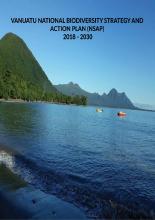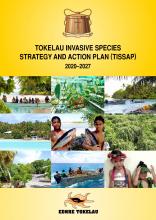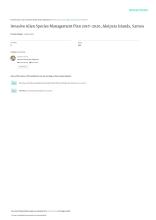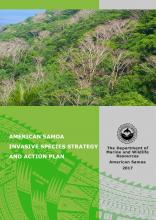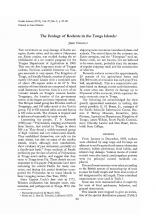The Ecology of Rodents in the Tonga Islands

BRB
Available Online
The influence on crop damage of Rattus norvegicus, Rattus rattus, and the native Polynesian rat, Rattus exulans, was studied during the establishment of a rat control program for the Tongan Department of Agriculture in 1969. This was the first long-term study of Tongan rodents. Previous scientific literature on Tongan mammals is very sparse. The Kingdom of Tonga, or Friendly Islands, consists of approximately 150 small islands with a combined area of about 256 square miles at lat 21 0 S. The majority of these islands are composed of raised coral limestone ; however, there is a row of six volcanic islands on Tonga's western border. Tongatapu, the location of the government center, is the largest and most important island. The Ha'apai island group lies 80 miles north of Tongatapu, and 150 miles north is the Vava'u group. Fiji is 420 nautical miles east and Samoa is 480 miles north. The climate is tropical and is influenced seasonally by trade winds. Since Captain Cook's first visit in 1773, Western civilization has brought trade, missionaries, and perhaps rats to Tonga. With this shipping came numerous introduced plants and animals. The arrival dates for the common rat, Rattus norvegicus, and the "European" roof rat, Rattus rattus, are not known, but are believed to be more recent, probably since the increase of regular shipping trade and the construction of wharves. Presently rodents account for approximately 20 percent of the agricultural losses and $50,000 worth of economic loss each year (Twibell, unpublished). This is a conservative estimate based on damage counts and observation. In some areas rats destroy or damage up to 50 percent of the coconuts, which represent the main economic crop in Tonga. THE INFLUENCE on crop damage of Rattus norvegicus, Rattus rattus, and the native Polynesian rat, Rattus exulans, was studied during the establishment of a rat control program for the Tongan Department of Agriculture in 1969. This was the first long-term study of Tongan rodents. Previous scientific literature on Tongan mammals is very sparse. The Kingdom of Tonga, or Friendly Islands, consists of approximately 150 small islands with a combined area of about 256 square miles at lat 21 0 S. The majority of these islands are composed of raised coral limestone ; however, there is a row of six volcanic islands on Tonga's western border. Tongatapu, the location of the government center, is the largest and most important island. The Ha'apai island group lies 80 miles north of Tongatapu, and 150 miles north is the Vava'u group. Fiji is 420 nautical miles east and Samoa is 480 miles north. The climate is tropical and is influenced seasonally by trade winds. Since Captain Cook's first visit in 1773, Western civilization has brought trade, missionaries, and perhaps rats to Tonga. With this shipping came numerous introduced plants and animals. The arrival dates for the common rat, Rattus norvegicus, and the "European" roof rat, Rattus rattus, are not known, but are believed to be more recent, probably since the increase of regular shipping trade and the construction of wharves. Presently rodents account for approximately 20 percent of the agricultural losses and $50,000 worth of economic loss each year (Twibell, unpublished). This is a conservative estimate based on damage counts and observation. In some areas rats destroy or damage up to 50 percent of the coconuts, which represent the main economic crop in Tonga.

